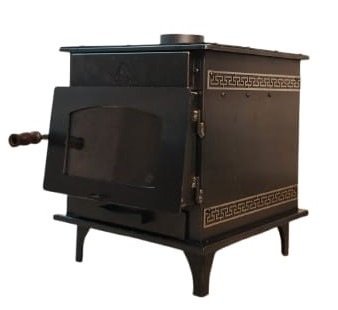If you’ve ever tried to keep a wood stove burning through a cold winter night, you know how little the rewards seem. You get a now-and-again touch of warmth, the smoke irritates your eyes, the woodpile feels like it’s vanishing, and the struggle just keeps going. But imagine loading the stove once, and having a steady, gentle heat coming from that same pile of wood for 40 hours straight. It’s not magic; it’s advanced engineering, paired with a simple, powerful idea. We’ll look at the Himalayan Rocket Stove’s principles and do some comparisons to see how it really performs alongside other models.
The Problem with Traditional Stoves
Traditional stoves use a single open combustion chamber. While they do produce heat, the overall energy output is very low. The most commonly experienced problems are:
- Incomplete Combustion: Wood stoves that do not use a high-temperature controlled burn will have a lot of incompletely combusted wood. The smoke and particulate matter come out through the chimney. This is incompletely burnt fuel. It is not only energy inefficient, but it is also polluting.
- Wasted Heat: Instead of radiating the heat to the living spaces, a lot of the heat produced by the fire goes directly up the chimney.
This inefficiency is the reason traditional stoves require refueling every few hours. It is a cycle of constantly adding wood to maintain a low heat level, with the majority of the wood’s potential energy being wasted.
The Himalayan Rocket Stove: A New Equation for Efficiency
A rocket stove functions on a different set of principles: one that extracts the highest possible energy from a single piece of wood. The design incorporates a vertical insulated “J-tube” or “L-tube” combustion chamber. This unique design pulls air at high velocity into the burn chamber, creating a powerful draft. The gases and smoke that would have escaped are now released. This is the secret behind a smokeless wood stove and the clean air wood heater.
The math is simple; a more complete burn leads to more heat on the same fuel. A traditional stove might only convert 50-60% of the wood’s energy into useful heat, while a rocket stove might exceed 90%. That means you get almost double the energy for the same amount of wood.
For a conventional stove: 1 kg of wood equals some heat over some hours.
For a rocket stove: 1 kg of wood equals 2 times (or more) the heat over far fewer hours.
This is what enables clean burn and makes it the most efficient wood-burning stove on the market.
The Math Behind the 40-Hour Burn Time
The extended burn time isn’t related to some kind of special wood. It’s related to the burner operating at low temperatures, slowly and steadily. Because the stove’s insulated chamber maintains very high temperatures, it doesn’t need to burn vigorously to produce a lot of heat. It can heat your space well with minimal burn. This means a single load of wood can be consumed at a controlled and slow rate with greatly extended release—in some cases, even 40 hours. This is the opposite of traditional stoves, which need to burn fuel quickly to maintain their version of heat, which is at a higher temperature and less efficient.
Aside from heating, this kind of control and efficiency makes it the best wood-burning cook stove for off-grid and emergency preparedness. It can simmer a stew for hours or boil water in no time, all with less fuel than other models.
Conclusion
To sum up, the calculations clearly favor the rocket stove. By extracting the maximum amount of energy from each piece of wood, it minimizes waste and boosts use efficiency. The convenience and sustainability it offers are greatly superior to what traditional stoves offer. It is not simply a heating device; it is an innovative approach to energy and resource management.
Frequently Asked Questions (FAQ)
Q: What’s the explanation behind the 40-hour burn time?
A: As with other stoves, the 40-hour burn time does not rely on the availability of fuel. It comes from the efficient, insulated burn design. With the slow-burning design, consistent heat is delivered for a long time.
Q: What kind of wood can I use?
A: The device is built to work with small sticks, twigs, and other types of biomass. Its high efficiency eliminates the need for large logs, which is perfect for the use of found fuel.
Q: Is the stove really smokeless?
A: Thanks to the secondary combustion process, the stove re-burns the smoke and gases. In this way, the output is almost smokeless, which is much cleaner both for indoor and outdoor use.
Q: Is the stove usable for both heating and cooking?
A: Yes, it is. The design makes it an all-in-one device for heating, boiling water, and cooking a room.


Recent Comments